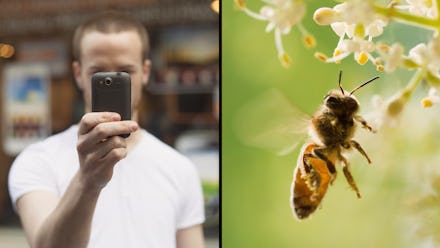The color in our photos could someday be more accurate, thanks to bees

Cameras embedded in drones and cell phones don’t always capture the vibrant colors we see with our eyes. Now, a group of scientists suggest that we should have tech that can see like bees — if that happens, our images will be more true to life.
Why bees are better than cameras
Humans and bees are both able to maintain something called “color constancy,” which is basically the ability to see and identify a color, regardless of variations in light. Color constancy helps us identify objects — even though the appearance of a banana may change depending on the day or the Instagram filter we put over it, we still know it’s yellow.
Cameras are not so great at color constancy. But, to be fair, honey bees have a really unfair advantage over any phone or camera drone: They have five eyes, two of which are dedicated to seeing the color of flowers. The three other smaller eyes have color receptors called “ocelli” which focus on the color of light.
Scientists think the ocelli feeds information about light to the parts of the brain that process color, and that combination is what allows for color constancy. It essentially stops bees from being confused about what color they’re seeing, unlike cameras, which remain fairly clueless.
Cameras could be much better at capturing color
Think about how cameras sometimes fail to relay color the way that we see it with our own eyes. It can make for a disappointing vacation photo — our family and friends will never know the utter beauty we saw firsthand.
Take this iPhone 7 photo of Innsbruck, Austria, for example:
The photo’s colors are distorted and desaturated. There’s no way of knowing what this street looked like to the human eye that night. But light changes the way we can see the same scene later on. This daytime camera photo of the same street in Innsbruck, for instance, is wildly different:
Essentially, bees can see colors way better than cameras can currently record them, and scientists are trying to apply their anatomy to future devices. They managed to parse apart a few mathematical principles based on the honey bees that could someday make our camera photos more accurate.
“We could soon have better camera colors, more accurate drone imaging and robots that can detect a full range of complex light condition,” according to a recent video about the study. “This is all thanks to our bee friends.”
For now, we can hope for a future where our group photos at the dive bar look anything like the night we remember.